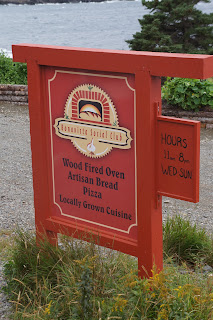 |
Looking through the rubble of a burned down house in Keels. (Photo: Claire McDougall)
|
As budding folklorists,
much of our business is documentation and preservation. An issue that
we've come up against in a few conversations is when to let things
go. In walking around Keels the other day, I came across the remnants of a burned
down house. I asked Jerry about it, and he told me it belonged to the
father of one of the current residents. Left abandoned
for some time after the man's death, the family finally decided it was
time to let it go and burn it down. Jerry was allowed to go through
the contents and retrieve anything of interest, as long as there were no
personal names attached to it. Many letters and documents
were allowed to burn with the structure. The family would have
simply preferred to let certain things live on in their own memories, and not be preserved for posterity and external review. As someone
interested in the history of a community, it appears to be a great
loss of source material, but the truth of the matter is that some
things go away, and not everything can or should be preserved.
I keep thinking about this
problem as it relates to the larger issue of rural revitalization and
what can be done about sustaining communities like Keels, who's
raison d'
être – the
fishery – is diminishing. There is no logic to a fishing
community beyond fishing. Tourism is touted as the saviour of rural
Newfoundland, but it can't save every community. Towns like Trinity
have been bought up and painted up by summer residents from away, who have recreated
a historical image that never really existed. Businesses are springing up to
cater to these tourists who have a taste for fine dining, fresh
greens and cultural performances that have never been a part of
“authentic” Newfoundland culture. It provides an economic base to
an ailing community, but the “new Newfoundland” bears little
resemblance to the lived experience of most Newfoundlanders. This is not necessarily a tragedy. I'm personally quite happy to be able to buy freshly baked multi-grain bread and garden vegetables around the bay as an alternative to bologna and chips.
 |
The Bonavista Social Club in Amherst Cove. An example of the "new" Newfoundland.
(Photo: Claire McDougall)
|
|
In talking to some of
the residents of Keels, I've heard an expression of sadness about the
declining population of the town. There are few
young people here, and they will likely leave the community when they
finish school, never to start a family here and keep the place going.
Two boys I spoke to in grade 10 are looking forward to getting the
heck out of Dodge and starting a new life elsewhere. And who can
blame them? After all, what teenager hasn't longed to leave their
home town at the first possible moment and discover what else there
is. But if the only people moving into a town are those who only spend a
few weeks in the summer, how can the community sustain itself year
round?
In the words
of the immortal Bruce Springsteen; “Everything dies,
baby, that's a fact. Maybe everything that dies someday comes back.” Maybe tourism will save rural Newfoundland. Maybe other economies will move into these towns and provide a new logic to sustain them. I'm certainly not equipped to speculate on the future of rural Newfoundland. But whether or not you grew up there, towns like Keels hold on to your heart in a way that makes it pretty hard to let them go. I hope we don't have to.
 |
The sun shines brightly over Keels harbour. (Photo: Erin Whitney)
|
|
No comments:
Post a Comment